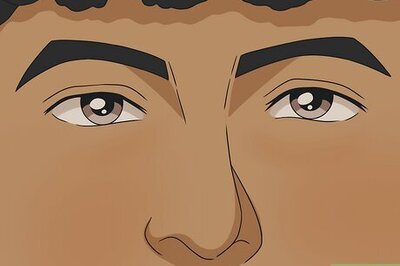
views
Fever and abdominal pain were wracking 30-year-old Amina Momin of Gujarat’s Kolat village. That and the recurrent vomiting. She was in no state to tend to her cattle anymore. Finally she checked into a local private hospital. A few days later, Amina was dead. It didn’t end there. Soon after, Dr Gagan Sharma and nurse Asha John, who had attended to the patient, died following similar symptoms.
This was in 2011. Now, nearly a decade after it was first detected in Gujarat, two people have died from Crimean-Congo haemorrhagic fever in Rajasthan’s Jodhpur and Jaisalmer. The state government has sent blood samples of 134 other people to the National Institute of Virology (NIV) in Pune for examination. A team is surveying impacted areas and distributing kits for prevention, said Rajasthan health minister Raghu Sharma in a statement.
But the disease, which is transmitted either through the bite of a tick, or contact with blood or tissues of infected animals or humans, and has a high fatality rate (from 5% to 80%), underscores the belief that India is fast becoming a hotspot for emerging illnesses. The last decade has seen infectious diseases such as Nipah, Avian influenza, pandemic influenza, severe acute respiratory syndrome (SARS) coronavirus and chikungunya virus emerging and re-emerging in the country.
News18 explains what the Crimean-Congo haemorrhagic fever is, why it is deadly and what the worrying implications are for healthcare in India:
What is Crimean-Congo haemorrhagic Fever? How is it transmitted?
The Crimean-Congo haemorrhagic fever, also known as CCHF or Congo fever, is caused by the tick-borne Nairovirus and causes "severe viral hemorrhagic fever outbreaks”, says the WHO. It is endemic to Africa, the Balkans, West Asia and other parts of the continent. Before 2011, the antibodies from the diseases were detected in Jammu and Kashmir and Maharashtra in India. Evidence of the virus and antibodies from an outbreak were also detected in human beings and domestic animals in Gujarat where the first reported cases were confirmed in 2011.
“The CCHF virus is transmitted to people either by tick bites or through contact with infected animal blood or tissues during and immediately after slaughter. The majority of cases have occurred in people involved in the livestock industry, such as agricultural workers, slaughterhouse workers and veterinarians. Human-to-human transmission can occur resulting from close contact with the blood, secretions, organs or other bodily fluids of infected persons. Hospital-acquired infections can also occur due to improper sterilization of medical equipment, reuse of needles and contamination of medical supplies,” says the WHO.
The disease was first definitely identified in Crimea, at the end of World War II, when Russian troops returned to aid in cultivating land left fallow. It was initially named Crimean haemorrhagic fever. Subsequently, it was found that this was the same virus as one isolated in 1956 from a febrile child in Stanleyville (now Kisangani) at the Democratic Republic of Congo. It was then named CCHF.
Is it new to India?
With the presence of CCHF virus confirmed in adjoining Pakistan, China and Afghanistan – countries that India has had trade ties with for years – scientists have long suspected the presence of the virus here.
In 1976, the Indian Journal of Medical Research published a study that tested 643 human samples and found nine, from Kerala and Pondicherry, to be positive with the CCHF virus-specific antibody. The study also found positive cases among livestock from different southern states and Maharashtra. Cases with haemorrhagic manifestations among hospital staff were reported from Ahmedabad in the 2011 incident.
It was speculated that there could be more cases in the state. Further research found suspected cases of infected livestock in villages around Bengal.
What are the signs and symptoms?
With a third of those infected dying, on an average, globally, identifying the disease early is a key factor in survival. The onset of symptoms is sudden – fever, muscle ache, dizziness, neck pain, stiffness, backache, headache, sore eyes and photophobia (sensitivity to light). The WHO says that, apart from these, there may also be “nausea, vomiting, diarrhoea, abdominal pain and sore throat early on, followed by sharp mood swings and confusion”. After two to four days, the agitation may be replaced by sleepiness and depression and the “the abdominal pain may localize to the upper right quadrant, with detectable hepatomegaly (liver enlargement)”, the WHO adds.
“Other clinical signs include tachycardia (fast heart rate), lymphadenopathy (enlarged lymph nodes), and a petechial rash (a rash caused by bleeding into the skin) on internal mucosal surfaces, such as in the mouth and throat, and on the skin,” adds the WHO. The rash, with time, might expand and there is usually some evidence of hepatitis. Severely ill patients may see rapid deterioration of kidneys and sudden liver failure or pulmonary failure after the fifth day of illness.
Can it be cured? What is the treatment?
Treatment for CCHF is mostly supportive and pharmaceutical options are, at best, limited.
In particular, patients need to pay attention to the fluid and electrolyte balance. The WHO also recommends “ventilation support for enough oxygenation, mild sedation and hemodynamic support depending upon the situation at the early stages of the disease in early stage of the disease presentation”. Delay in the diagnosis and supportive care decreases the efficacy of treatment and can greatly aggravate the disease with fatal consequences. The antiviral drug ribavirin has been used to treat CCHF infection with apparent benefit and both oral and intravenous formulations seem to be effective, says the WHO. But the use of the drug has been controversial, with uncertainties about its antiviral efficacy in clinical case studies.
Is India's diagnostic capacity up to the challenge?
Early diagnosis is key. But it also depends on the geographical area and the overlap of similar haemorrhagic fevers (like dengue or leptospirosis) in that region. This is important, since diagnosis is based on recognising the clinical symptoms and then confirmation by detecting the virus or viral RNA. But, as a 2013 study, Crimean-Congo Hemorrhagic Fever: Current Scenario in India, noted, the laboratory diagnosis of CCHF includes the reverse transcription polymerase chain reaction (RT-PCR) and real-time RT-PCR assay...for the rapid detection of viral RNA in the acute phase requires instruments and consumable that are “cost expensive and out of the financial reach of many local laboratories. This can delay the timely diagnosis and in turn early management of patients”. During the 2011 outbreak, NIV Pune, and the High-Security Animal Disease Laboratory (HSADL) in Bhopal were the only two facilities that had the capacity to provide diagnosis on CCHF virus.
Why are public health officials worried?
The 2013 study added, “During the period of 2010–2012, a large number of referred CCHFV suspected human samples from Gujarat state and other parts of the country were screened by the NIV, Pune but no evidence of positivity recorded from any other state apart from Gujarat.” But with the short incubation period, non-specific symptoms that are often misdiagnosed with other haemorrhagic fevers, the risks are very real. Those, who might be carrying the diseases without knowing, could infect others – such as companions, family members, co-travellers or healthcare providers, said doctors.
The 2011 outbreak was followed by a resurgence in 2012. The first-infected was a resident of Bavla taluka in Ahmedabad, who died a week later. His treating physician was also infected through accidental contact. Afterwards, suspected family, hospital staff and animals were treated and only the animal samples were found to be positive for ticks. The 2010-12 period saw a number of cases to be positive for the diseases in the state, during screening NIV Pune. The 2013 study noted: “The fact that such huge population of the above mentioned livestock is in close contact with the human beings indicates the possibility of spread of this virus in different parts of India.”



















Comments
0 comment